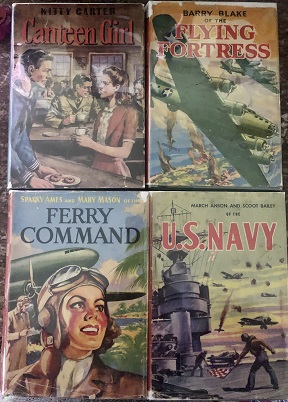Adventure stories taking place against a backdrop of World War II. In each book, a different branch or auxilliary of the armed forces is featured. The series is noteworthy for spotlighting a wide variety of opportunities for young women -- canteen services for those with homefront responsibilities, nursing, shipboard radio communications, and even piloting bombers around the world as part of the naval ferry command.

Be forewarned: there is a staggering amount of casual racism in some of the books, particularly those authored by Ruby Lorraine Radford -- not just the jingoistic talk of "Japs" and "Dagos" that's unfortunately typical of wartime books, but free-and-easy use of the "n" word, stereotypical dialect and behavior, and, in one case, a heroine who literally carries a Confederate flag in her footlocker and brandishes it at hospital parties.
Roy Snell's contributions to the series, while they do contain some problematic material, are not nearly so offensive to modern sensibilities. (In looking for publishing information in WorldCat, I found it interesting that Snell wrote his Master's thesis at the University of Chicago, during the World War I period, on the topic of "The Moral Significance of Children's Reading.")
|
- SALLY SCOTT OF THE WAVES -- By Roy J. Snell. Illustrated by
Hedwig Jo Meixner. 1943, Whitman.
Sally Scott carries a secret when she goes through WAVES training -- a
new kind of radio, the invention of an elderly man from her hometown.
- BARRY BLAKE OF THE FLYING FORTRESS -- by Gaylord Du Bois.
Illustrated by J. R. White. 1943, Whitman.
Pilot Barry Blake encounters plenty of blood and thunder on his way to his South Pacific combat post.
- NANCY DALE, ARMY NURSE -- by Ruby Lorraine Radford. Illustrated
by Henry E. Vallely. 1944, Whitman.
Nancy Dale, recent graduate from a hospital nursing program, joins the Army Nurse Corps and finds herself serving in Australia. Will she be able to find out what happened to her MIA brother, Tommy?
- KITTY CARTER, CANTEEN GIRL -- by Ruby Lorraine Radford.
Illustrated by Henry Vallely. 1944, Whitman.
Motherless Kitty Carter, responsible for the care of her younger brother, thought she'd have no chance to do her bit until she learned about the American Red Cross Canteen Service. Will she be able help break up a ring of traitors and clear the name of an innocent man?
- DICK DONNELLY OF THE PARATROOPS -- Named author Gregory Duncan.
By Marshall McClintock. Illustrated by Francis Kim. 1944, Whitman.
Dick Donnelly wasn't his real name and soldiering wasn't his chosen profession. He volunteered for the paratroops because he itched or excitement, action, and thrills -- and it offered the quickest means of getting at the enemy with whom he had a personal score to settle.
- NORMA KENT OF THE WACS -- by Roy J. Snell. Illustrated by
Hedwig Jo Meixner. by Snell. 1943, Whitman.
- MARCH ANSON AND SCOTT BAILEY OF THE U.S. NAVY -- Named author,
Gregory Duncan. By Marshall McClintock. Illustrated by Henry E. Vallely.
1944, Whitman.
It's the Air Corp vs. the Submarine Service in this story of two hometown best friends who join the Navy together and then go in different directions.
- SPARKY AMES AND MARY MASON OF THE FERRY COMMAND
-- by Roy J.
Snell. Illustrated by Erwin L. Darwin. 1943, Whitman.
Mary and Sparky, both skilled and experienced pilots, deliver fighting planes around the world.
|
